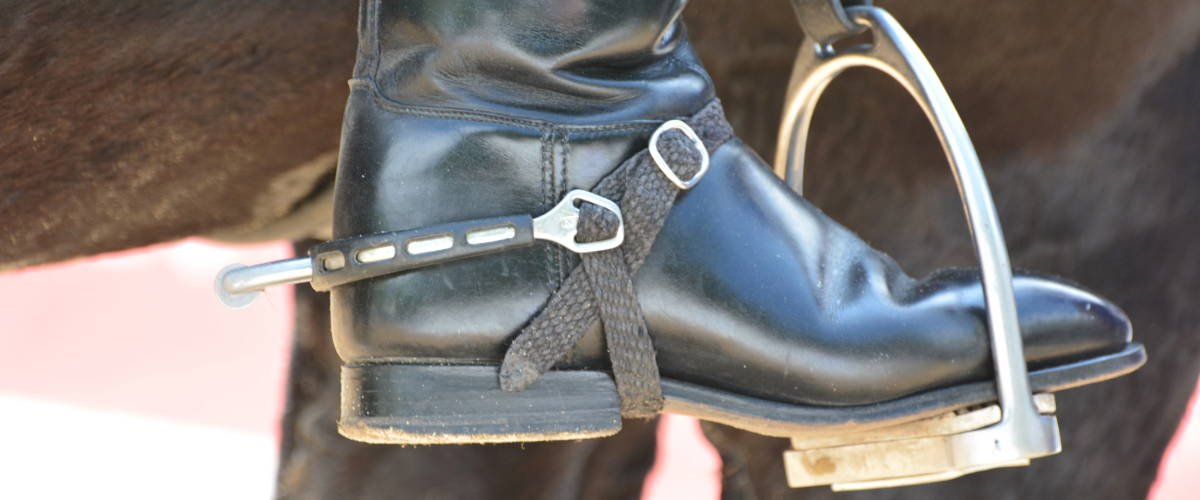English spurs are a small but impactful tool in the equestrian world, designed to refine communication between the rider and the horse. Spurs can aid in encouraging forward movement, improving lateral work, or providing precision during advanced maneuvers. However, their effectiveness depends significantly on the type of spurs chosen, particularly the shank style.
What Are Spurs?
Spurs are a metal attachment that fits over the heel of the rider's boot, held securely by straps. They are used as an extension of the leg to deliver subtle cues, complementing the use of leg pressure and reins. The choice of spur should always consider the rider’s skill level, the horse's sensitivity, and the discipline being practiced.
Types of Spur Shanks
1. Prince of Wales (POW) Shank
- Design: Features a short, flat, and slightly rounded end.
- Usage: Commonly used for subtle cues, making them ideal for beginner to intermediate riders or sensitive horses.
- Benefits: Provides gentle reinforcement without overwhelming the horse.
2. Rounded or Knob Shank
- Design: A smooth, ball-like end on the shank.
- Usage: Suitable for sensitive horses or riders who need a forgiving spur. Often used in dressage or for young horses.
- Benefits: Reduces the chance of inadvertently delivering harsh cues.
3. Swan Neck Shank
- Design: Features an upward-curving shank.
- Usage: Often used in disciplines requiring precision, like dressage. This design allows riders with long legs or those on smaller horses to make better contact.
- Benefits: Provides clarity in leg aids without contorting the rider's leg position.
4. Rowel Spurs
- Design: A rotating wheel at the end of the shank, available in smooth or mildly toothed versions.
- Usage: Commonly used by experienced riders for advanced disciplines.
- Benefits: Delivers precise, rolling cues that can be gentler than static shanks when used correctly.
5. Disc Spurs
- Design: A small, smooth disc replaces the shank’s end.
- Usage: Ideal for encouraging forward movement and used often in showjumping or eventing.
- Benefits: Gentle, rolling contact that minimizes the risk of pressure points.
6. Offset Shank
- Design: The shank angles away from the heel.
- Usage: Offers better alignment for riders with specific leg positions or boot styles.
- Benefits: Enhances precision by accommodating individual rider anatomy.
7. Long or Dressage Shank
- Design: Extended shank length for clearer cues.
- Usage: Primarily used in dressage for horses trained to respond to nuanced aids.
- Benefits: Allows riders to give subtle signals without moving their leg significantly.
Choosing the Right Spurs
For the Horse
- Sensitive Horses: Opt for rounded or knob spurs for a gentle touch.
- Experienced Horses: Consider rowel or swan neck spurs for advanced communication.
For the Rider
- Beginner Riders: Start with Prince of Wales spurs for simplicity and safety.
- Advanced Riders: Experiment with rowel or dressage shanks for fine-tuned aids.
For the Discipline
- Dressage: Swan neck or long shank spurs offer clarity and elegance.
- Showjumping: Disc or knob spurs provide effective, controlled signals.
- Eventing: Choose spurs based on the phase—rounded for cross-country, rowel for dressage.
Using Spurs Responsibly
Spurs are tools, not shortcuts, and should never replace proper training and effective leg aids. Misuse or overuse can cause discomfort or even harm to the horse. Always ensure a light touch, proper leg position, and consistent cues when using spurs.
Spurs can enhance the partnership between horse and rider, but the key lies in selecting the right shank for your needs. Whether you’re competing in dressage or perfecting lateral work, Aitken’s Saddlery offers a range of English spurs to suit every rider and horse.
Subscribe

